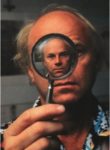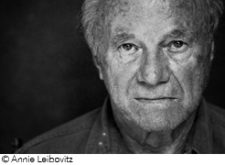
James Rosenquist
American, 1933-2017
Somewhere, 1981
color lithograph
28 x 28 in.
SBMA, Museum purchase with funds provided by the National Endowment for the Arts and the Contemporary Collectors Group in memory of Rowe Giesen
1982.51.1

James Rosenquist. Chambers Street studio, New York, 1980. Photo © Bob Adelman.
“Pop Art. I’ve never cared for the term, but after half a century of being described as a Pop artist I’m resigned to it,” he said. “Still, I don’t know what Pop Art means, to tell you the truth.” - James Rosenquist
POSTSCRIPT
A pioneer of the Pop art movement, James Rosenquist rearranges and overlaps images and symbols to create fragmented icons that compel the viewer to examine the familiar in a more abstract and provocative way. At the brink of the Digital Revolution, Rosenquist contemplated the human relationship to technology, the environment, and religion in this stunning portfolio of seven lithographs featuring imagery derived from the sciences, nature, and mass media.
Rosenquist’s references to mass-produced goods and to magazines, films and other aspects of the mass media, together with his dispassionate and seemingly anonymous technique, ensured that he was regarded as one of the key figures in the development of Pop art in the United States. In 1948, while still in school, he won a scholarship to study at the Minneapolis School of Art, and from 1952 to 1955 he studied painting at the University of Minnesota. In 1955, he moved to New York to study at the Art Students League on a scholarship. He earned his living as a billboard painter from 1957, and in 1960 he began to apply similar techniques of grossly enlarged and fragmented images to huge paintings.
- Paddle8.Inc

James Rosenquist, photo by Annie Leibovitz
COMMENTS
James Rosenquist, Pop Art Pioneer, Dies at 83
By KEN JOHNSON APRIL 1, 2017
James Rosenquist, who helped define Pop Art in its 1960s heyday with his boldly scaled painted montages of commercial imagery, died on Friday in New York City. He was 83 years old.
His wife, Mimi Thompson, said Mr. Rosenquist died at his home after a long illness.
Like his contemporaries Andy Warhol and Roy Lichtenstein, Mr. Rosenquist developed a powerful graphic style in the early 1960s that traditionalists reviled and a broad public enthusiastically embraced.
The Pop artists took for their subject matter images and objects from the mass media and popular culture, including advertising, comic books and consumer products. They also employed techniques that until then had been associated primarily with commercial and industrial methods of production, like silk screening or, in Mr. Rosenquist’s case, billboard painting.
Mr. Rosenquist himself drew on his experience painting immense movie billboards above Times Square and a Hebrew National sign in Brooklyn.
It was while working in New York as a sign painter by day and an abstract painter by night that he had the idea to import the giant-scale, broadly painted representational pictures from outdoor advertising into the realm of fine art.
“Was importing the method into art a bit of a cheap trick?” the critic Peter Schjeldahl wrote in The New Yorker in 2003 on the occasion of a ballyhooed retrospective of Mr. Rosenquist’s work at the Guggenheim Museum in New York. “So were Warhol’s photo silk-screening and Lichtenstein’s limning of panels from comic strips.
“The goal in all cases,” Mr. Schjeldahl added, “was to fuse painting aesthetics with the semiotics of media-drenched contemporary reality. The naked efficiency of anti-personal artmaking defines classic Pop. It’s as if someone were inviting you to inspect the fist with which he simultaneously punches you.”
Mr. Rosenquist drew inspiration, too, from the tradition of Surrealistic collage, as well as from the montage designs of contemporary advertising, to create disjunctive compositions of cropped and fragmented images of cars, movie stars, food products and domestic appliances.
Though painted by hand in a lucidly simplified realistic style, the juxtapositions of images remain mysterious. The paintings could be viewed both as critiques of modern consumerism and as glimpses into the collective American consciousness.
“The art’s formal ingenuity can jump out at you as forcefully as the grill of a Ford or a fragment of Marilyn Monroe’s lips or the cap from a Pepsi bottle or a stack of Fiesta dishes in a dish rack,” Michael Kimmelman wrote in The New York Times, also in 2003.
Mr. Rosenquist’s paintings rarely contained overt political messages, but his best-known work, the enormous "F-111," was made in 1964 and 1965 in part as a protest against American militarism. In it, the image of a modern fighter plane stretching 86 feet across a grid of 51 canvas and aluminum panels is interrupted by images of a colossal tire, a beach umbrella, a mushroom cloud, spaghetti and tomato sauce, and a little girl under a chrome hair dryer that resembles a warhead.
Mr. Rosenquist meant to sell the painting as separate panels, but the collector Robert Scull bought it whole and kept it that way. It is now in the collection of the Museum of Modern Art in New York.
James Albert Rosenquist was born in Grand Forks, N.D., on Nov. 29, 1933, and grew up in various towns in Minnesota and Ohio before his parents settled in Minneapolis in 1944. His father, Louis, was an airplane mechanic, among other things. His mother, Ruth, an amateur painter who could also fly a plane, encouraged his interests in art, and he won a scholarship to study at the Minneapolis Institute of Arts when he was in junior high school.
Mr. Rosenquist studied art at the University of Minnesota from 1952 to 1954, and during his summer vacation in 1953 he worked for a contractor painting gas station signs, storage tanks and grain silos.
After receiving an associate degree in studio art, he went to work for a billboard company painting advertisements for movies, liquor and soft drinks. One assignment, during the Davy Crockett craze that swept the United States on the heels of a Walt Disney mini-series, was to paint eight-foot-wide coonskin caps.
In 1955, Mr. Rosenquist received a one-year scholarship to the Art Students League in New York, arriving with $350 in his pocket, he said. He studied there with Will Barnet, Edwin Dickinson and George Grosz, among others.
He also began frequenting the Cedar Tavern in Greenwich Village, a gathering place for painters and poets. “There was Bill de Kooning, Franz Kline,” Mr. Rosenquist told The Times in 2003.
After leaving school the next year, he held a series of odd jobs before returning to sign painting, joining the sign painters union and working mostly for the Artkraft Strauss Sign Corporation, which painted some of the largest billboards in the world.
“Much of the aesthetic of my work comes from doing commercial art,” Mr. Rosenquist said. “I painted pieces of bread, Arrow shirts, movie stars. It was very interesting. Before I came to New York I wanted to paint the Sistine Chapel. I thought this is where the school of mural painting exists. You were painting things up close, like big chocolate cakes. In Brooklyn, I painted Schenley whiskey bottles two stories high, 147 of them over every candy store.”
He continued the work until 1960, when he quit for good after two co-workers fell from a scaffold and died.
That year he rented the former studio of Agnes Martin at 3-5 Coenties Slip, a building on the East River in Lower Manhattan where Robert Indiana, Ellsworth Kelly, Jasper Johns and Jack Youngerman also had studios.
Until then, Mr. Rosenquist had been making paintings consisting of allover fields of brushmarks in the spirit of Abstract Expressionism. Now, influenced in part by the works of Robert Rauschenberg and Mr. Johns, whom he had gotten to know, he began to use his sign painting skills.
During the course of his career, Mr. Rosenquist experimented with sculptural assemblage and environmental installations, and he sometimes attached three-dimensional objects to his pictures. But he remained mainly a representational painter. In later years, some of his paintings approached a kind of futuristic, kaleidoscopic abstraction, but the play with different sorts of images and illusions persisted.
Mr. Rosenquist’s first marriage, to Mary Lou Adams, ended in divorce. He is survived by Ms. Thompson, his second wife; his son John, from his first marriage, his daughter Lily, from his second marriage, and a grandson, Oscar.
Mr. Rosenquist’s first solo exhibition, at the Green Gallery in 1962, sold out. That same year his work was included in a survey of new art at Sidney Janis Gallery called “International Exhibition of the New Realists” that put what would soon come to be known as Pop Art on the map of contemporary consciousness.
In 1965, he showed “F-111” in his first exhibition at the Leo Castelli Gallery, which by then represented most of major Pop artists.
The painting was subsequently exhibited at the Jewish Museum and then taken on a tour or Europe. Besides the show at the Guggenheim in 2003, Mr. Rosenquist had museum retrospectives at the National Gallery of Canada in Ottawa in 1968; the Whitney Museum of American Art in New York in 1972; and the Denver Art Museum in 1985. He had an exhibition at the Haunch of Venison Gallery in London, now defunct, in 2006, and a solo show at the Acquavella Galleries in New York in 2012. His most recent exhibition opened last fall at the Galerie Thaddaeus Ropac in Paris. And the Museum Ludwig in Cologne, Germany, will host an exhibition of his work later this year.
For many years he worked out of a loft building on Chambers Street that he bought in 1977 for $120,000. In 1978, he was appointed by President Jimmy Carter to a six-year term on the National Council on the Arts, a group that advises the National Endowment for the Arts.
In later years he spent much of his time in Aripeka, Fla., where he kept a home, an office and studio space. A catastrophic fire destroyed the properties in 2009.
William Acquavella, the New York art dealer, said that Mr. Rosenquist lost a significant amount of work in the fire.
“He just rebounded from it,” he said. “Another guy would have had a tougher time bouncing back. But he enjoyed working, he enjoyed creating things, and he enjoyed painting.”
Mr. Rosenquist also had homes in Bedford, N.Y., and Miami. Recently, he had been spending most of his time in New York City, Ms. Thompson said.
In 2009, Mr. Rosenquist published an autobiography, “Painting Below Zero: Notes on a Life in Art,” written with David Dalton. Reviewing it in The New York Times, Dwight Garner called it “a ruddy and humble book, lighted from within by the author’s plainspoken, blue-collar charm.”
nytimes.com
